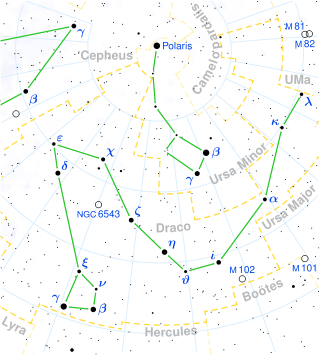Theta Draconis
Theta Draconis (θ Dra / θ Draconis) is a fourth-magnitude star in the northern circumpolar constellation of Draco. Parallax measurements place it at an estimated distance of 68.6 light-years (21.0 parsecs) from Earth.[2]
 | |
| Observation data Epoch J2000 Equinox J2000 | |
|---|---|
| Constellation | Draco |
| Right ascension | 16h 01m 53.3457s[1] |
| Declination | +58° 33′ 54.905″[1] |
| Apparent magnitude (V) | 4.1190[2] |
| Characteristics | |
| Spectral type | F9 V[1] |
| U−B color index | +0.11[3] |
| B−V color index | +0.53[3] |
| Astrometry | |
| Radial velocity (Rv) | -8.5[1] km/s |
| Proper motion (μ) | RA: -319.51[2] mas/yr Dec.: 334.97[2] mas/yr |
| Parallax (π) | 47.54 ± 0.12[2] mas |
| Distance | 68.6 ± 0.2 ly (21.03 ± 0.05 pc) |
| Absolute magnitude (MV) | 2.50[2] |
| Details | |
| Mass | 1.21[4] M☉ |
| Radius | 2.5[4] R☉ |
| Luminosity | 8.7[5] L☉ |
| Surface gravity (log g) | 4.13[5] cgs |
| Temperature | 6,290[4] K |
| Metallicity [Fe/H] | +0.20[5] dex |
| Rotational velocity (v sin i) | 27[6] km/s |
| Age | 3.1[7] Gyr |
| Other designations | |
| Database references | |
| SIMBAD | data |
Chinese name
In Chinese, 紫微左垣 (Zǐ Wēi Zuǒ Yuán), meaning Left Wall of Purple Forbidden Enclosure, refers to an asterism consisting of θ Draconis, ι Draconis, η Draconis, ζ Draconis, υ Draconis, 73 Draconis, γ Cephei and 23 Cassiopeiae.[8] Consequently, the Chinese name for θ Draconis itself is 紫微左垣二 (Zǐ Wēi Zuǒ Yuán èr, English: the Second Star of Left Wall of Purple Forbidden Enclosure.),[9] representing 上宰 (Shǎngzǎi), meaning The First Premier.[10] 上宰 (Shǎngzǎi) is westernized into Shang Tsae by R.H. Allen with meaning "the Minor Steward" but it was for η Dra (Aldibain)[11]
Properties
This star is 21% more massive than the Sun and has a radius 2.5 times the Sun's.[4] It is radiating 8.7 times the luminosity of the Sun[5] from its outer atmosphere at an effective temperature of 6,290 K.[4] This temperature is what gives it the yellow-white hue of an F-type main sequence star with a stellar classification of F9 V.[1]
References
- "tet Dra -- Spectroscopic binary". SIMBAD. Centre de Données astronomiques de Strasbourg. Retrieved 2010-11-21.
- van Leeuwen, F. (November 2007). "Hipparcos, the New Reduction". Astronomy and Astrophysics. Centre de Données astronomiques de Strasbourg. 474 (2): 653–664. arXiv:0708.1752. Bibcode:2007A&A...474..653V. doi:10.1051/0004-6361:20078357. Retrieved 2010-11-21.
- Mermilliod, J.-C. (1986). "Compilation of Eggen's UBV data, transformed to UBV (unpublished) origin=SIMBAD". Catalogue of Eggen's UBV Data. Bibcode:1986EgUBV........0M.
- Kaler, James B. "THETA DRA (Theta Draconis)". Stars. University of Illinois. Retrieved 2010-11-21.
- Mallik, Sushma V. (December 1999), "Lithium abundance and mass", Astronomy and Astrophysics, 352: 495–507, Bibcode:1999A&A...352..495M
- Hoffleit; et al. (1991). "Bright Star Catalogue". VizieR (5th Revised ed.). Centre de Données astronomiques de Strasbourg. Retrieved 2010-11-21.
- Decin, G.; et al. (November 2003), "Age Dependence of the Vega Phenomenon: Observations", The Astrophysical Journal, 598 (1): 636–644, arXiv:astro-ph/0308294, Bibcode:2003ApJ...598..636D, doi:10.1086/378800
- (in Chinese) 中國星座神話, written by 陳久金. Published by 台灣書房出版有限公司, 2005, ISBN 978-986-7332-25-7.
- (in Chinese) AEEA (Activities of Exhibition and Education in Astronomy) 天文教育資訊網 2006 年 6 月 10 日
- (in Chinese) English-Chinese Glossary of Chinese Star Regions, Asterisms and Star Name Archived 2008-09-24 at the Wayback Machine, Hong Kong Space Museum. Accessed on line November 23, 2010.
- Star Name - R.H. Allen p. 210